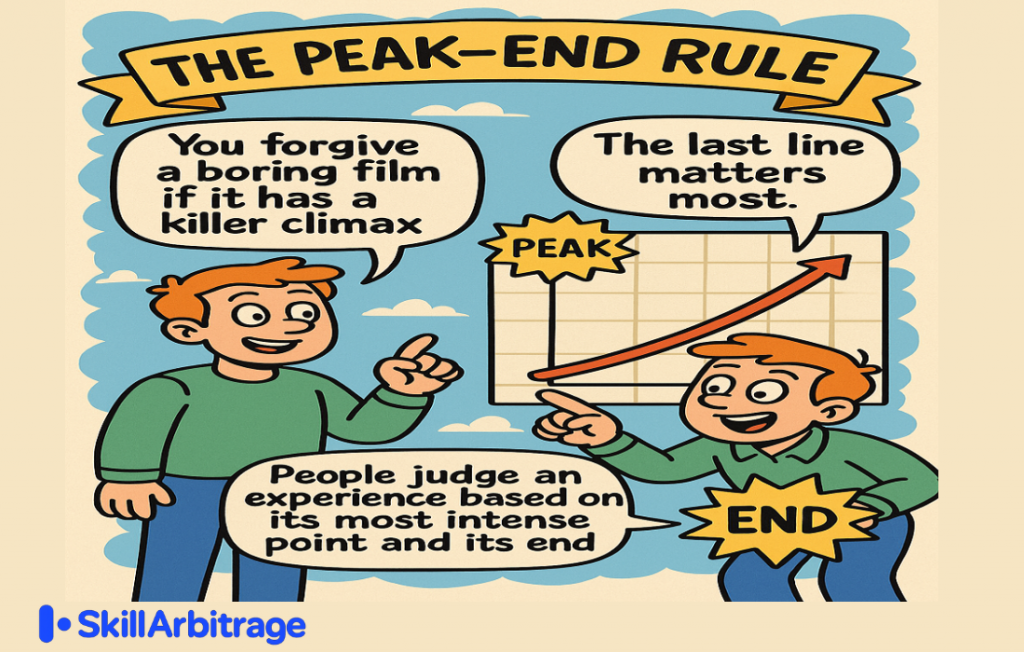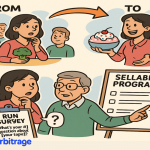This blog offers a close look at the peak-end rule, providing readers with templates and tips to apply it instantly. It would be beneficial for content writers, marketers, and strategists seeking to apply the powerful peak-end rule in their content.
Introduction
Have you seen the classic film “Gone with the Wind”? Almost everyone who has seen that film remembers one iconic scene, where the male lead says “Frankly my dear I don’t give a damn!” with terribly hot snootiness and walks out.
If you haven’t seen that film, perhaps you recall the last season of Mirzapur or Patal Lok. Look back and you will find that you will remember that one thrill-inducing scene from the whole series.
This is not an individual trait but a universal law, known as the peak-end rule. This rule states that people do not remember entire experiences; instead, they recall a peak in their emotions and the conclusion of the experience.
And it applies to most content, whether audio-visual or textual, that we encounter. Consumers do not remember every word of the content, but they remember powerful lines that make them feel something, and the punch line at the end. So when these two coincide, making your last line the most powerful line of the piece, then you have achieved customer satisfaction, customer loyalty, and goodwill, with content.
The peak-end Rule is one of the most underused, yet powerful, psychological triggers in copywriting.
What is the peak-end rule?
Coined by Nobel Prize winner Daniel Kahneman, the peak-end rule states That People judge an experience based on its most intense point and its end, rather than the entire journey.
It’s why:
- You forgive a boring film if it has a killer climax.
- You remember a brand video if it ends with a goosebump moment.
- You take action on a long email, just because the final line hit hard.
Here’s a snapshot of how it works.
In copywriting, your ending is not a goodbye; it’s your killer move that makes the customer turn to you again and again.
Why endings matter more than you think
When we start writing a piece of content, we craft every line and word to convey value and drive action. Despite this, it is evident that the last line is what the customer remembers most of all.
Let’s compare two email endings.
A.
“Hope this helped! Let me know if you have any questions.”
B.
“The next 30 days could change your career — if you’re willing to start today. Are you in?”
Which one are you more likely to remember? Which one makes you feel something?
B wins. Every time.
Because it’s not just ending the message — it’s sealing the memory.
And in a noisy content world, what’s remembered… gets acted on.
Customers remember a piece of content much more vividly and feel more satisfied when the peak-end rule is integrated into the marketing strategy. This improves customer loyalty and a loyal customer is a brand’s best advocate.
If they have a good experience, they will tell their friends and family. Result? Your brand gets talked about without you spending anything extra on the marketing.
Here’s a detailed look at how the peak-end rule boosts customer loyalty and improves retention.
From Apple to Walmart, brands have incorporated the peak-end rule to increase customer satisfaction.
Brands that nail the peak-end rule
Big brands not only use the peak-end Rule in their copy but also incorporate it in key consumer experiences.
Interestingly, this is why when you go to celebrate a birthday at a restaurant, they bring out a cake and sing the birthday song with you…to ensure the peak in your experience.
Let’s see the most famous examples of global brands doing it.
1. Apple
Apple product launches and their “one more thing” moment at the last are classic examples of the peak-end Rule. During their keynotes, Apple often keeps the announcement of their next most innovative or surprising product for last.
This strategy ensures the audience leaves with a memorable final impression, talking about the event for a long time.
2. MailChimp
This email marketing service provider makes sending out mass emails look fun. The service provides a peak moment by displaying a nervous, sweaty monkey finger hovering over a big, red “send” button right before an email is sent out.
This amusing animation adds a fun peak moment to the user experience, making the whole process feel less like a chore and more engaging.
3. Landing pages
Check out Zerodha’s Coin app or Cred’s early launches.
The copy doesn’t end with “Start Now.”
It ends with lines like:“You’ve worked hard for your money. Now make it work for you.”
“You don’t need to be rich to use Cred. But it might help you get there.”
See what they did?
They turned the CTA into an emotional trigger, at the end of the journey.
That’s peak-end psychology in action.
And if you know how, you can apply this fabulous lever in your copy as well.
How?
Try these sample lines.
5 high-retention closing lines
Use these lines at the close. In places like:
- The last sentence of your email
- Final line of a YouTube script
- CTA on your landing page
- The conclusion of your blog or ad
1. “You’ve come this far. What’s stopping you now?”
Why it works:
Creates momentum + self-reflection = action.
Cultural nuance:
In India’s aspiration-driven culture, where personal growth and seizing opportunities are celebrated, this closing line taps into the societal push to overcome hesitation and “make it happen.”
It feels like a trusted mentor or family member challenging you to take the next step, resonating with our deep-rooted need for shared encouragement and accountability, and driving action through emotional momentum.
2. “Your future self will thank you for this.”
Why it works:
Triggers long-term identity — a powerful psychological motivator.
Cultural nuance:
In India, where long-term planning and family-oriented decision-making are prioritized, this line resonates with the fundamental social need to secure a better future for oneself and one’s loved ones.
3. “You already know what to do. This is just your nudge.”
Why it works:
Makes the reader feel smart, not sold to. Drives subtle confidence.
Cultural nuance:
In India’s trust-sensitive market, where consumers value authenticity and personal connection, this line positions the brand as a supportive friend.
It aligns with the cultural preference for subtle, relationship-based persuasion, which is common in community-driven decisions, making users feel empowered and respected, thereby increasing their likelihood of acting.
4. “Not everyone will do this. But the ones who do? You’ll see them winning.”
Why it works:
Injects exclusivity + FOMO + challenge.
Cultural nuance:
In India’s competitive and status-conscious society, where standing out in academics, careers, or entrepreneurship is highly valued, this line taps into the cultural drive to be among the elite.
It evokes the fear of missing out (FOMO) prevalent in India’s fast-paced urban culture and plays on the collective aspiration to be a “winner”.
5. “If you’re still reading this, you’re not average. Let’s go.”
Why it works:
Turns attention into affirmation → affirmation into action.
Cultural nuance:
In India’s collectivist yet aspirational culture, where individual achievement is celebrated within community validation, this line affirms the user’s uniqueness while inviting them into a shared journey.
It mirrors the cultural pride in being “different” yet part of a supportive group.
The peak-end rule can also be used explicitly for CTAs. Here are some CTAs that command respect effortlessly.
Bonus: 3 CTA lines that hit hard
You can use these as standalone buttons, link texts, or closing lines before a CTA.
- “Yes. I want in.”
→ Ownership-driven CTA that feels personal. - “I’m ready to stop playing small.”
→ Emotional identity CTA — perfect for career/growth content. - “Show me how the top 1% does it.”
→ For aspirational, insight-led content. Triggers curiosity + ambition.
How to integrate the peak-end rule in copy in 3 simple steps
You don’t need to overhaul your copy to integrate the peak-end rule. You just need to structure it better. Follow these simple steps.
Step 1: Find the emotional peak
→ Where’s the moment of the biggest “aha” or transformation? Highlight it.
Step 2: Save your best line for last
→ Don’t bury your insight mid-way. If you have a powerful line, don’t let it lose impact by being sandwiched by fluff. End with your punch.
Step 3: Align the ending with your CTA
→ Make sure your last line flows naturally into what you want them to do.
Example:
“The best time to build your brand was 5 years ago.
The second-best time is now.
Start with this 5-minute personal brand audit.”
That’s peak-end mastery in 3 lines.
Final Word
The next time you write a video, an email, or a landing page, don’t treat the ending as a sign-off.
It’s your final word. Your chance to imprint a memory.
If your copy were a story, the end is the part they’ll talk about at dinner.
Make it worth remembering.
FAQs
Q1: What if I have multiple CTAs?
Make sure your emotional CTA is last.
Even if you have earlier links/buttons, end with the line that leaves the deepest impact.
Q2: Can I use this in B2B content?
Absolutely.
Here’s a peak-end line from a SaaS pitch:
“If you’re serious about reducing churn by 30%, this is your next step.”
Professional, clear, but still packs a punch.
Q3: Should every email or video end dramatically?
Not always.
But every ending should do one of the following:
- Reinforce your core message
- Drive action
- Leave a strong emotional note
Even a quiet ending can echo — if it’s written with clarity and care.







 Allow notifications
Allow notifications
